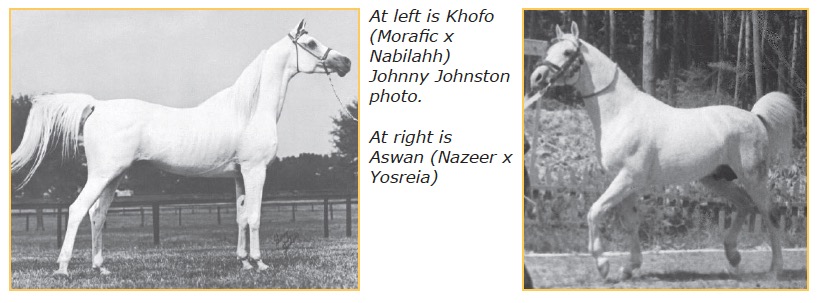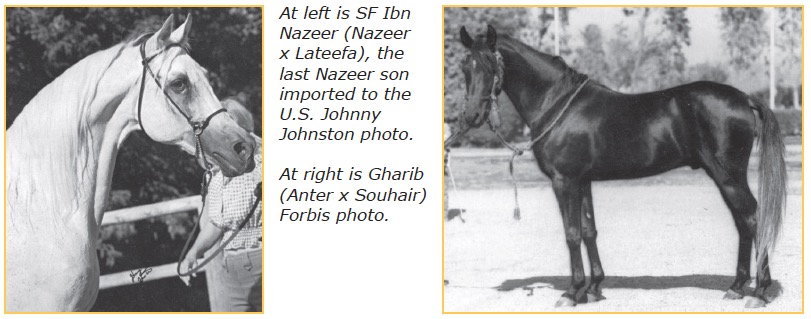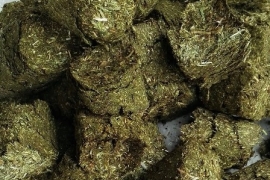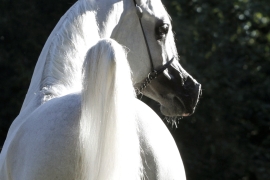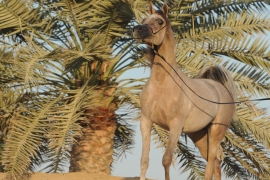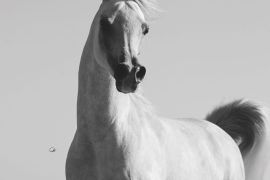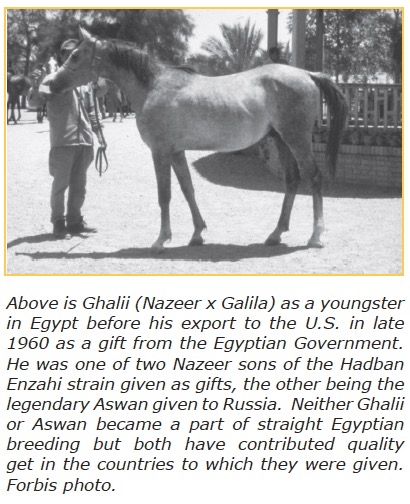
I grew up in the city knowing nothing about horses as a child other than they seemed as big as elephants, at least the ones my grandfather raised. He died just before I began my studies at Michigan State University. Little did I know that he was a friend of some of the people at MSU who maintained the Arabian breeding program there. While I was attending that university in the 1960s the Egyptian stallion Ghalii (Nazeer x Galila) was there. He was a gift from the Egyptian government to the U.S. Secretary of Agriculture Ezra Benson who appropriately gave Ghalii to MSU to add to its long established Arabian breeding program. I did not learn about him until 1970 when a nearby Arabian breeder Mr. Perry gave such glowing descriptions of this impressive and noble stallion. By then Ghalii had died so I never got to see him but Mr. Perry’s descriptions conjured up visions in my head of the noble horse of the desert which I had been learning about from the writings of Homer Davenport, the Blunts and Carl Raswan. I learned that Ghalii was of the Hadban Enzahi strain and I began to notice that stallions of this strain seemed to generate much favor in Egypt’s history.
By now there is hardly anyone has not heard of the name Nazeer, the “all seeing, all knowing Saker eyed” pearl white stallion of the past. He is perhaps the most famous Egyptian stallion and sire of the Hadban Enzahi strain. An entire article on the Hadban Enzahi strain 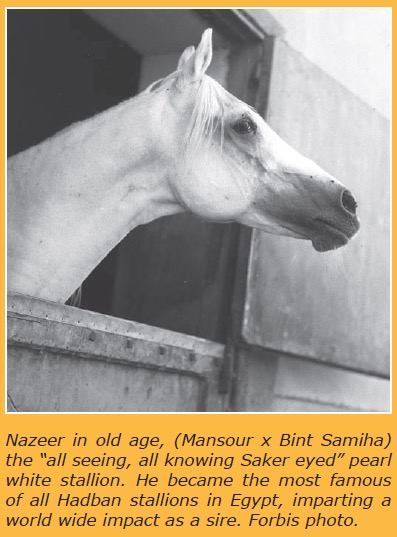 could fill a book and Dr. Hans Nagel has already written some very thought provoking words on this strain. But I would like to just share a few reflections on it since its name seems to conjure up such a high degree of respect.
could fill a book and Dr. Hans Nagel has already written some very thought provoking words on this strain. But I would like to just share a few reflections on it since its name seems to conjure up such a high degree of respect.
In Egyptian lines the Hadban Enzahi strain begins with a young mare titled “Venus” brought to the stud of Egypt’s Khedive Abbas II about 1893. She had come from the famed and noble Shammar tribe, perhaps not too far from where the 2007 WAHO conference was held in Syria. When Venus foaled the filly Hadba in 1894 the legacy of the Hadban in Egypt commenced. Like a large oak tree with two main branches, Hadba had two daughters to carry on the family, Bint Hadba El Saghira and Gamila.
In the earliest of times of Egypt’s RAS government stud, the stallion Ibn Rabdan had emerged as a much admired horse and sire which brought considerable merit to the Hadban. He was a grandson of Gamila. Pictures of him confirm the favorable comments about his “world champion” like silhouette, though less than extreme head. As a sire he often produced horses of his striking dark color with very little if any white markings. Often they had his good length of neck, strong sloping shoulders and prominent withers imparting an overall “Adonis” like attractiveness in form. He was 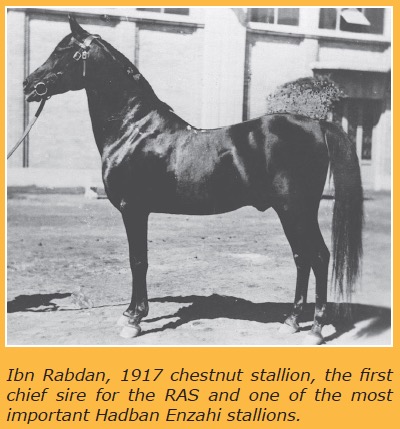 considered a dominant sire imparting his color and looks with the exception of the occasional powerful dam that would keep his form but imprinting her grey color and usually improving on his head type. Ibn Rabdan also had a half brother Baiyad (Mabrouk x Bint Gamila), a Hadban stallion who is found in pedigrees of Ansata Nile Echo and Glorieta Zafir.
considered a dominant sire imparting his color and looks with the exception of the occasional powerful dam that would keep his form but imprinting her grey color and usually improving on his head type. Ibn Rabdan also had a half brother Baiyad (Mabrouk x Bint Gamila), a Hadban stallion who is found in pedigrees of Ansata Nile Echo and Glorieta Zafir.
All of the other Hadban stallions of fame after Ibn Rabdan were from the other large branch of the tree, Bint Hadba El Saghira. Whereas the line from Gamila goes quickly to the stallions Ibn Rabdan and Baiyad, the big branch of Bint Hadba El Saghira’s line was blessed with many females to extend the strain. After all, without the mares we are without the strain. Bint Hadba El Saghira added two more branches to the tree through her daughters Samiha and Bint Rustem.
SAMIHA
It appears that Samiha’s line was popular among racing enthusiasts in Egypt. Her daughter Fayza provided racing stock though eventually this line died out at the RAS. But Samiha’s other daughter Bint Samiha put her on the map by producing Nazeer. Suffice it to say whole books could be written about Nazeer. His influence through bot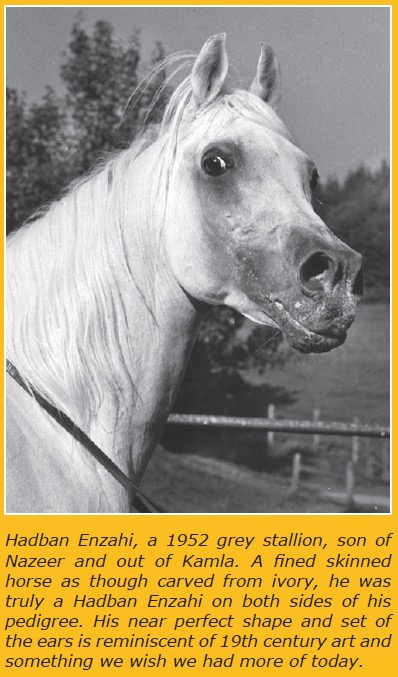 h sons and daughters has given great honor to the family name. Sire of 101 get, a huge number in Egypt in his time, he crossed well with all strains. Some of his famed sons were of the same strain as he was making them first generation pure in the strain Hadbans. These include such stallions as: Hassan and Galal at the EAO, Hadban Enzahi in Europe, Aswan in Russia and Ghalii and SF Ibn Nazeer in North America.
h sons and daughters has given great honor to the family name. Sire of 101 get, a huge number in Egypt in his time, he crossed well with all strains. Some of his famed sons were of the same strain as he was making them first generation pure in the strain Hadbans. These include such stallions as: Hassan and Galal at the EAO, Hadban Enzahi in Europe, Aswan in Russia and Ghalii and SF Ibn Nazeer in North America.
Bint Samiha also had two daughters, Samha (x Baiyad) and Shams (x Mashaan), each making the Samiha family larger.
While the first get of legendary Nazeer did not reach U.S. shores until 1958, eleven years before that Bint Samiha’s blood came to the U.S. in 1947 in the form of the mare Mamdouha (Kheir x Samha x Bint Samiha). Mamdouha was carrying a filly Gamila (x Enzahi) when imported. This became the first Egyptian Hadban line in America. Today it is still admired with such examples as Ali Zafir (Ruminaja Ali x Glorieta Zaafira), now back in Egypt and the lovely black mare Rhapsody In Black (Thee Desperado x Aliashahm RA) to name a few.
In Egypt Samha produced the lovely Kamla, mother of Europe’s great Hadban Enzahi and also Bint Kamla. Aside from imparting an ivory like fineness, Hadban Enzahi also had the most perfect Arabian ears, just the right size and perfectly placed on his head much like 19th century artists engravings. Kamla’s line seemed to continue a particular kind of refinement and beauty. Egypt retained her daughter Bint Kamla who produced Shaarawi, successor at the EAO to his legendary sire Morafic. It just seemed to get better as Bint Kamla’s daughter Lutfia would become Europe’s source of great beauty and style while her sister Nazeema at the EAO would produce such charmers as Nizam (x Shaarwawi), Misk and his brother Okaz (x Wahag), and the handsome Ibn Nazeema (x Ameer). Samha also produced Zahia (x Sid Abouhom). Zahia became the premier Hadbah mare for Al Badeia Stud in Egypt, esteemed as the dam line of Al Adeed Al Shaqab.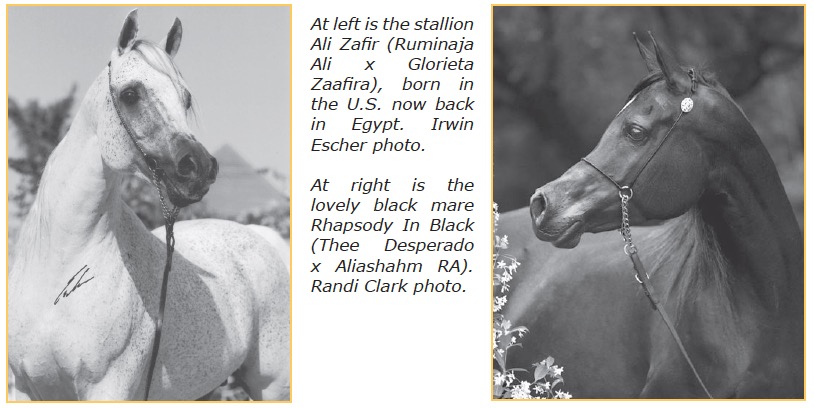
Bint Samiha’s daughter Shams founded the Maysouna family that is equally admired for its beauty and style. This is the dam line of the great broodmare sire Ansata Abu Sudan. It is also the dam line of famed sires Makhsous, The Minstril and more recently the handsome double Hadban Laheeb Al Nasser (Al Adeed Al Shaqab x Bint Saida Al Nasser). Shams other daughter Sherifa (x Gassir) represented the Hadban line in the EAO sires Hafid Anter and Aybac.
Bint Rustem was the other daughter of Bint Hadba El Saghira. She produced the mahogany bay stallion Mashhour who, though narrowly represented, sired the important EAO sire Seef and a number of important daughters. The Bint Rustem branch is perhaps the largest family of Hadbans and is carried forward via two daughters Hind and Salwa, both by Ibn Rabdan, making them double Hadban.
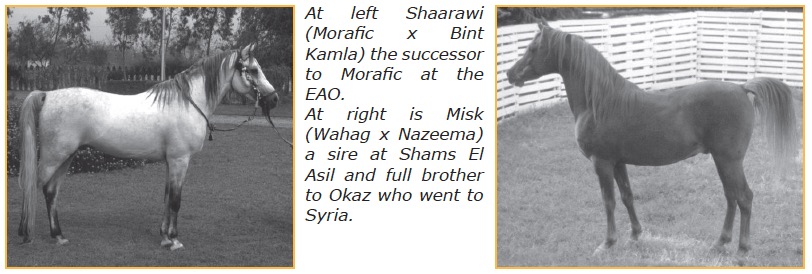
Space does not permit extending this whole large family but suffice it to say that Hind’s line is a big one represented by such famous stallions as Russian sire Aswan (Nazeer x Yosreia); Europe’s Ibn Galal and Shaker El Masri (sire of El Shaklan); Galal, Farazdac and Gad Allah at the EAO, Imperial Mahzeer in Qatar, and Khofo, Simeon Shai, and Thee Desperado in the U.S.
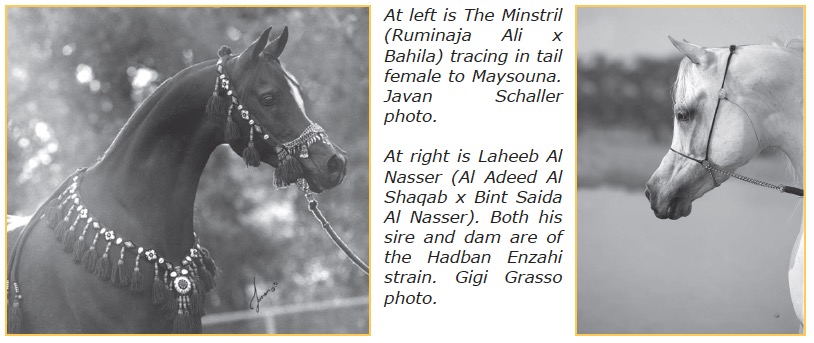
Salwa is represented by such notable stallions as: Egypt’s Nasralla (Balance x Sehr) and Ashour (Anter x Lateefa); Morocco’s El Sud El Aaly (Nazeer x Lateefa); Europe’s Gharib (Anter x Souhair); and SF Ibn Nazeer in Canada and the U.S.
Maybe I am being a bit subjective here because these
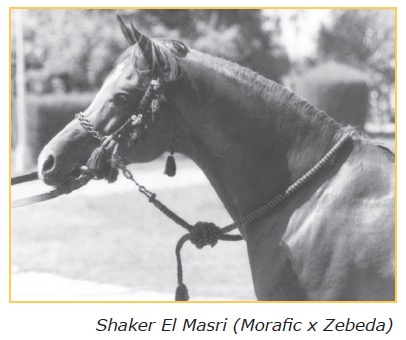 Egyptian horses of the Hadban Enzahi strain come in a variety of sizes, shapes and colors, but it seems that stallions of this strain often prove to be great sires in the long run. I see often horses of excellent proportions with great shoulders, stylish movement, good refinement and a harmonious overall balance of athletic qualities with noble Arabian type. The name “Venus” was associated with the Roman goddess of love and beauty. How fortunate it was that the mare “Venus” came to Egypt in 1893 from the timeless campfires of her Shammar Bedouin keepers. It is a tribal offering that has become an Egyptian treasure--the Hadban Enzahi strain--the mother of great sires.
Egyptian horses of the Hadban Enzahi strain come in a variety of sizes, shapes and colors, but it seems that stallions of this strain often prove to be great sires in the long run. I see often horses of excellent proportions with great shoulders, stylish movement, good refinement and a harmonious overall balance of athletic qualities with noble Arabian type. The name “Venus” was associated with the Roman goddess of love and beauty. How fortunate it was that the mare “Venus” came to Egypt in 1893 from the timeless campfires of her Shammar Bedouin keepers. It is a tribal offering that has become an Egyptian treasure--the Hadban Enzahi strain--the mother of great sires.